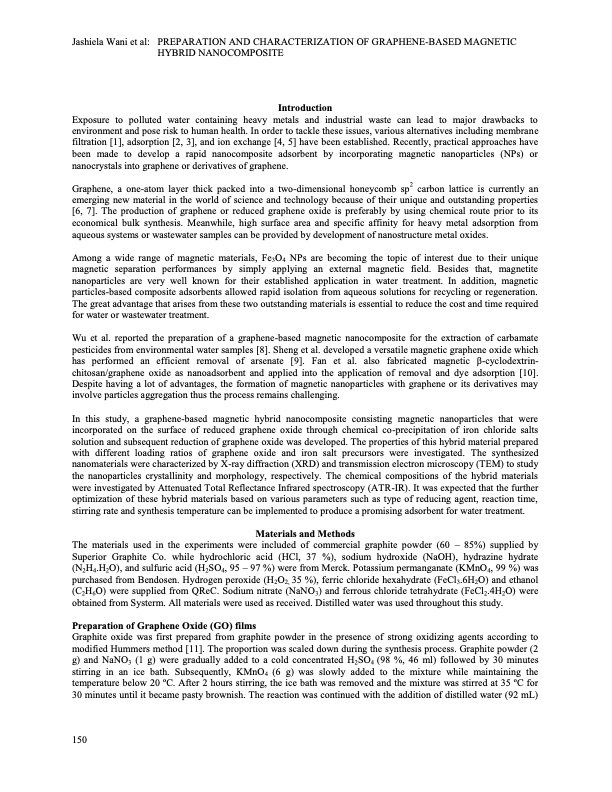
PDF Publication Title:
Text from PDF Page: 002
Jashiela Wani et al: PREPARATION AND CHARACTERIZATION OF GRAPHENE-BASED MAGNETIC HYBRID NANOCOMPOSITE Introduction Exposure to polluted water containing heavy metals and industrial waste can lead to major drawbacks to environment and pose risk to human health. In order to tackle these issues, various alternatives including membrane filtration [1], adsorption [2, 3], and ion exchange [4, 5] have been established. Recently, practical approaches have been made to develop a rapid nanocomposite adsorbent by incorporating magnetic nanoparticles (NPs) or nanocrystals into graphene or derivatives of graphene. Graphene, a one-atom layer thick packed into a two-dimensional honeycomb sp2 carbon lattice is currently an emerging new material in the world of science and technology because of their unique and outstanding properties [6, 7]. The production of graphene or reduced graphene oxide is preferably by using chemical route prior to its economical bulk synthesis. Meanwhile, high surface area and specific affinity for heavy metal adsorption from aqueous systems or wastewater samples can be provided by development of nanostructure metal oxides. Among a wide range of magnetic materials, Fe3O4 NPs are becoming the topic of interest due to their unique magnetic separation performances by simply applying an external magnetic field. Besides that, magnetite nanoparticles are very well known for their established application in water treatment. In addition, magnetic particles-based composite adsorbents allowed rapid isolation from aqueous solutions for recycling or regeneration. The great advantage that arises from these two outstanding materials is essential to reduce the cost and time required for water or wastewater treatment. Wu et al. reported the preparation of a graphene-based magnetic nanocomposite for the extraction of carbamate pesticides from environmental water samples [8]. Sheng et al. developed a versatile magnetic graphene oxide which has performed an efficient removal of arsenate [9]. Fan et al. also fabricated magnetic β-cyclodextrin- chitosan/graphene oxide as nanoadsorbent and applied into the application of removal and dye adsorption [10]. Despite having a lot of advantages, the formation of magnetic nanoparticles with graphene or its derivatives may involve particles aggregation thus the process remains challenging. In this study, a graphene-based magnetic hybrid nanocomposite consisting magnetic nanoparticles that were incorporated on the surface of reduced graphene oxide through chemical co-precipitation of iron chloride salts solution and subsequent reduction of graphene oxide was developed. The properties of this hybrid material prepared with different loading ratios of graphene oxide and iron salt precursors were investigated. The synthesized nanomaterials were characterized by X-ray diffraction (XRD) and transmission electron microscopy (TEM) to study the nanoparticles crystallinity and morphology, respectively. The chemical compositions of the hybrid materials were investigated by Attenuated Total Reflectance Infrared spectroscopy (ATR-IR). It was expected that the further optimization of these hybrid materials based on various parameters such as type of reducing agent, reaction time, stirring rate and synthesis temperature can be implemented to produce a promising adsorbent for water treatment. Materials and Methods The materials used in the experiments were included of commercial graphite powder (60 – 85%) supplied by Superior Graphite Co. while hydrochloric acid (HCl, 37 %), sodium hydroxide (NaOH), hydrazine hydrate (N2H4.H2O), and sulfuric acid (H2SO4, 95 – 97 %) were from Merck. Potassium permanganate (KMnO4, 99 %) was purchased from Bendosen. Hydrogen peroxide (H2O2, 35 %), ferric chloride hexahydrate (FeCl3.6H2O) and ethanol (C2H6O) were supplied from QReC. Sodium nitrate (NaNO3) and ferrous chloride tetrahydrate (FeCl2.4H2O) were obtained from Systerm. All materials were used as received. Distilled water was used throughout this study. Preparation of Graphene Oxide (GO) films Graphite oxide was first prepared from graphite powder in the presence of strong oxidizing agents according to modified Hummers method [11]. The proportion was scaled down during the synthesis process. Graphite powder (2 g) and NaNO3 (1 g) were gradually added to a cold concentrated H2SO4 (98 %, 46 ml) followed by 30 minutes stirring in an ice bath. Subsequently, KMnO4 (6 g) was slowly added to the mixture while maintaining the temperature below 20 oC. After 2 hours stirring, the ice bath was removed and the mixture was stirred at 35 oC for 30 minutes until it became pasty brownish. The reaction was continued with the addition of distilled water (92 mL) 150PDF Image | GRAPHENE-BASED MAGNETIC HYBRID NANOCOMPOSITE

PDF Search Title:
GRAPHENE-BASED MAGNETIC HYBRID NANOCOMPOSITEOriginal File Name Searched:
JashielaWani-20-1-16.pdfDIY PDF Search: Google It | Yahoo | Bing
Salgenx Redox Flow Battery Technology: Power up your energy storage game with Salgenx Salt Water Battery. With its advanced technology, the flow battery provides reliable, scalable, and sustainable energy storage for utility-scale projects. Upgrade to a Salgenx flow battery today and take control of your energy future.
| CONTACT TEL: 608-238-6001 Email: greg@infinityturbine.com | RSS | AMP |